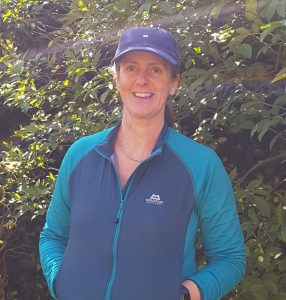It is the perfect time of the year to plant additional pollinator-friendly native trees in your garden, park or on your farm.
In order to survive, pollinators need flowers that produce lots of nectar (for energy) and pollen (for protein). Planting an individual or small group of trees will provide a vital source of food, particularly in spring, and are low maintenance once planted.
Willow is a very important food source in early spring when Bumblebee queens emerge from hibernation. Other important native species like Rowan, Crab apple, Wild cherry, Whitethorn and Blackthorn will provide important food for pollinators to help avoid ‘hunger gaps,’ or times when there are no nectar or pollen-rich flowers in bloom.
Native Trees and shrubs
Willow supports c.266 insect species and c.160 lichens. Goat or Grey willows are wonderful plants for pollinators as they provide lots of pollen and nectar in their tiny flowers in early spring when there is little else in flower. Willows can be grown easily from cuttings. Goat and Grey Willow will grow up to 10m in height.
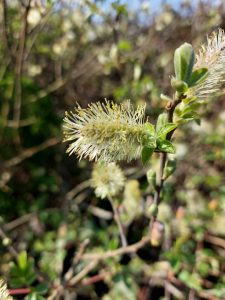
Rowan (8-10m) is also known as ‘Mountain Ash’ as it has similar leaves to the ash tree. Rowan supports c.28 insects and c.125 lichens. It is a very attractive tree, with white flower clusters in spring for pollinators, and red berries in autumn.
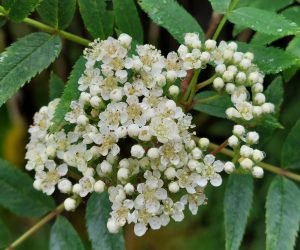
Crab Apple (10m) can be found in many of our old native hedgerows. It supports c.93 insect species, including pollinators, and crab apples provide food for birds and mammals in autumn.
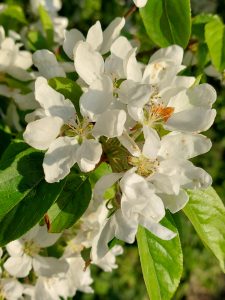
Wild Cherry (18-25m) is a pretty native tree that will provide food for pollinators as well as fruit for birds.
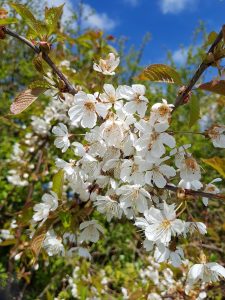
Hawthorn/Whitethorn (15m) is also called the ‘Maybush’ because of its beautiful display of blossoms each May. It is a common hedgerow species but can also be grown as a standalone tree – a very wildlife-friendly option, producing lots of flowers for pollinators and red haws in autumn for birds to enjoy. Hawthorn supports c.149 insect species.
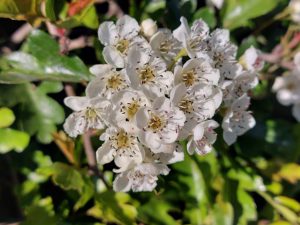
Blackthorn (6-7m) provides a home for c.109 insect species. Related to cherries and plums, the fruit of the blackthorn resemble small plums and are enjoyed by lots of animals, including wood mice, finches and foxes.
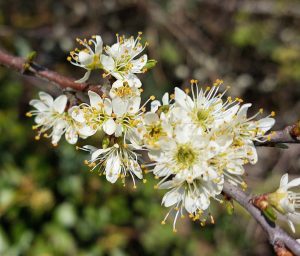
Holly (15m) is widespread throughout the country. It flowers from May to July and these are followed in late autumn by the familiar bright scarlet berries. Its evergreen, glossy leaves are stiff and leathery with spiny margins. These leaves – together with those of Ivy – is the larval foodplant of the Holly Blue Butterfly.
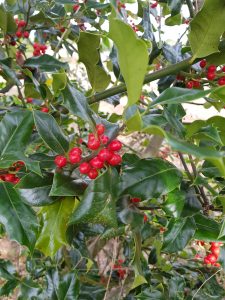
Next steps – Where and how to plant
Is your site suitable? There are some places you mustn’t plant trees, it may already be a valuable semi-natural habitat for pollinators and other biodiversity, such as:
- grassland that has never been ploughed, as it may be species-rich grassland
- wetland
- heathland
- sites with rare or protected species
- also, archaeological sites.
Other considerations: what space is available and if there are buildings nearby and possible underground services like water pipes and cables. Further guidance can be found here https://www.woodlandtrust.org.uk/plant-trees/advice/where/
Try to source local provenance native trees, they’re overall best for our native wildlife and there’s less of a risk of importing tree pests and diseases. Or you could try to collect some local native tree seeds from your local area to sow, grow and plant the following year.
It’s best to plant bare root trees when they’re dormant, between November to March. Here’s some good tips on how to plant your trees https://www.woodlandtrust.org.uk/plant-trees/advice/how-to-plant/
Further information on our native trees can be found on the Tree Council of Ireland site https://www.treecouncil.ie/native-irish-trees
*Insect & lichen diversity based on UK Research and refers to Britain. It is included here to demonstrate how important different native trees are to biodiversity. Ref. Southwood, T.R.E (1961) The number of species of insect associated with various trees. J. Animal Ecology 30:1-8. Rose F. and Harding, P.T. (1978) Pasture and woodlands in Lowland Britain and their importance for the conservation of the epiphytes and invertebrates associated with old trees. Nature Conservancy Council & The Institute of Terrestrial Ecology.
By Ruth Wilson, Farmland Officer, All-Ireland Pollinator Plan

